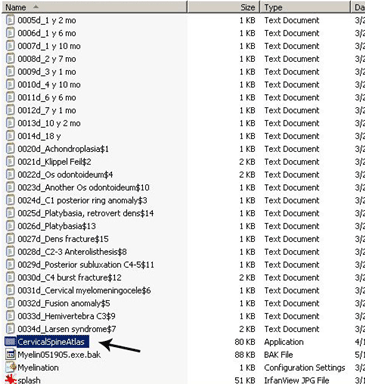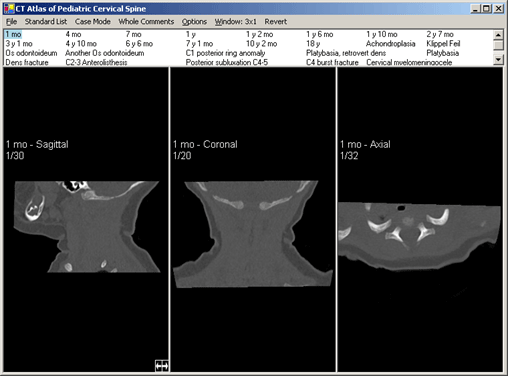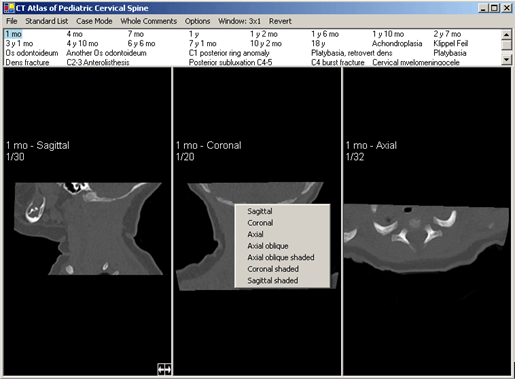How to Use
Introduction
Computed Tomography (CT) evaluation of the pediatric cervical spine is complicated by the changing appearance of normal structures during childhood. While hard copy atlases of the cervical spine exist, these often show only a few images of the cervical spine and may consist primarily of schematic drawings. In an effort to create a more comprehensive image reference, we constructed an online, large data set, digital atlas which demonstrates the normal appearance of the cervical spine at various ages throughout childhood. In this electronic exhibit we show a digital atlas of normal CT cervical spine exams in 14 patients ranging in age from 1 month to 18 years old which are listed simply by their age. In addition, we have included a teaching file of 15 abnormal exams initially listed by diagnosis.
To launch the program:
You can start the program from the Start menu, in the Programs folder, under CervicalSpine Atlas. Alternatively, you can run the program by opening up the atlas folder and clicking on the file CervicalSpineAtlas.exe. You can put a shortcut on the desktop for ease of starting the program.

By default, the module opens in Case Mode (Single Patient, Multiple Series) showing a different series of a selected patient (by default, the normal 1 month old patient) in each viewing window. No comments or shading are present on these default images. Please see additional instructions below to enable these and other helpful features.

Basic Image Navigation - Quick Start
The box below the menubar contains a list of cases/patients in the module. The highlighted case/patient is the one currently assigned to the viewing windows. You can click on any case in the list to start with a new case in the viewing windows, or you can click on the forward and reverse arrows in the first viewing windowto move through the cases. Teaching file cases may be viewed in known or unknown format by clicking the Optionsmenu and selecting Alternate List Names.
Hold down the right mouse button to select a different series to place in a viewing window. You can use this to select the option of color shaded images, as well as to choose the plane of images. The series listed in bold are the ones available for the given patient being viewed.

To scroll forwards or backwards through a series, left-click on a window and hold the left mouse buttonas you move the mouse up or down. By default, all appropriately linked windows will scroll at the same time as the window you scroll. If you want to unlink or re-link image scrolling, go into the Options menu and uncheck or check the Link Image Sets When Scrollingoption.
Menubar Controls

Case list selection:
The default case list is the Standard List, which contains all of the cases. By clicking on Standard Liston the menubar you can switch to another list format.
Expanded Listoption is not applicable for this particular module.

The Checked Onlylist adds checkboxes next to the Standard List cases. This allows you to customize exactly which cases are to be viewed. In this mode, only the checked cases will be shown in the viewing windows.
Mode selection:

The initial display mode is Case Mode. You can change the display mode by clicking Case Modeon the menubar and then selecting one of the three options that appear. This will then change the menu title to the newly selected option.
Case Modeallows you to compare multiple series of a single patient. Only one patient will be displayed at a time (the default is the patient in the upper left window). You must right-click on each viewing window to load different series for the selected patient. Changing the selected patient will change all the viewing windows and load the selected series for the new patient.
Compare Modeallows you to simultaneously compare the same series over multiple different patients. If you right-click on a viewing window and select a series, the program will open that series for all of the selected patients. Only one series can be shown at a time in compare mode. To scroll forwards or backwards through a series, left-click on a window and hold the left mouse button as you move the mouse up or down.
Sheet Modeallows you to view one series from one patient in detail. It opens the series currently residing in the first viewing window into an array viewing mode simulating a printed sheet of film.

Comment selection:
The image sets have comments associated with them. Some comments apply to every image for a given case/patient, while other comments are specific for a given series or even a single image. There are four modes for viewing comments, which can be changed from the comments menu.
No Comments: No comments shown.
Show Single Image Comments: When you move the mouse over an image, any comments associated with the image will pop up and be shown.
Show All Image Comments: A small comment window will pop up at the bottom of every image window and stay visible, showing the comments associated with each window's image.
Options:

Scrolling Through Series: To scroll through a series, left-click on a window and hold the left mouse button as you move the mouse up or down. This will scroll forwards or backwards through the series. If the series are linked, as they are by default, all appropriately linked viewing windows will scroll at the same time as the viewing window you scroll. If you want to unlink or re-link the image scrolling, go into the Options menu and uncheck or check the Link Image Sets When Scrolling option.
Alternate List Names: Each of the cases with abnormalities have two names so that they may be viewed in known or unknown format. To toggle between the two names, simply click the Options menu and check or uncheck Alternate List Names.
Window selection:
The viewing windows start out as a 3x1 array. To change the layout of the viewing windows, left-click the Window: 3x1 menu option. This will pop up a small window with a 5x5 grid as shown:

Move the mouse around on the grid to select the new viewing window arrangement layout that you want, and then click it. The viewing windows will rearrange themselves and load the appropriate series automatically.
